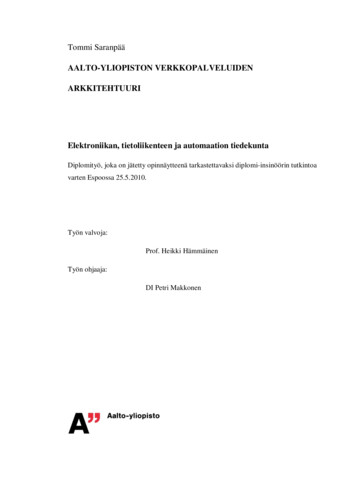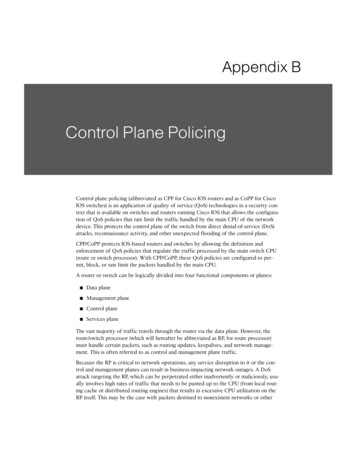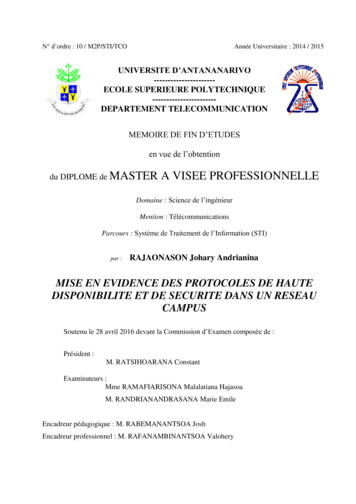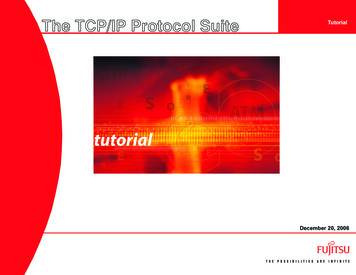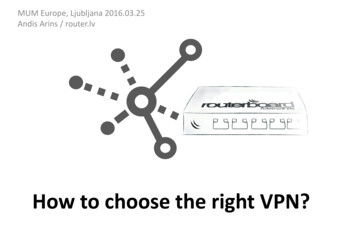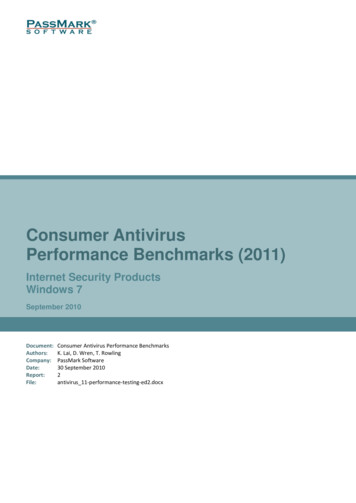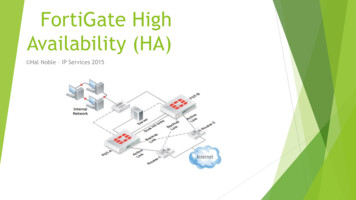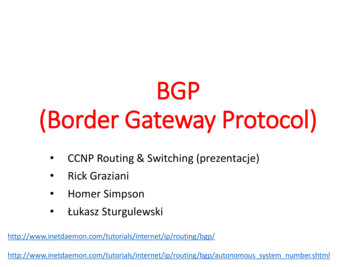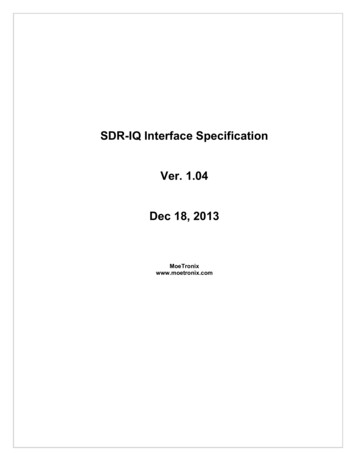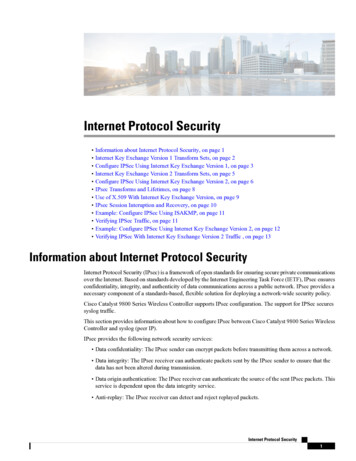
Transcription
Internet Protocol Security Information about Internet Protocol Security, on page 1 Internet Key Exchange Version 1 Transform Sets, on page 2 Configure IPSec Using Internet Key Exchange Version 1, on page 3 Internet Key Exchange Version 2 Transform Sets, on page 5 Configure IPSec Using Internet Key Exchange Version 2, on page 6 IPsec Transforms and Lifetimes, on page 8 Use of X.509 With Internet Key Exchange Version, on page 9 IPsec Session Interuption and Recovery, on page 10 Example: Configure IPSec Using ISAKMP, on page 11 Verifying IPSec Traffic, on page 11 Example: Configure IPSec Using Internet Key Exchange Version 2, on page 12 Verifying IPSec With Internet Key Exchange Version 2 Traffic , on page 13Information about Internet Protocol SecurityInternet Protocol Security (IPsec) is a framework of open standards for ensuring secure private communicationsover the Internet. Based on standards developed by the Internet Engineering Task Force (IETF), IPsec ensuresconfidentiality, integrity, and authenticity of data communications across a public network. IPsec provides anecessary component of a standards-based, flexible solution for deploying a network-wide security policy.Cisco Catalyst 9800 Series Wireless Controller supports IPsec configuration. The support for IPSec securessyslog traffic.This section provides information about how to configure IPsec between Cisco Catalyst 9800 Series WirelessController and syslog (peer IP).IPsec provides the following network security services: Data confidentiality: The IPsec sender can encrypt packets before transmitting them across a network. Data integrity: The IPsec receiver can authenticate packets sent by the IPsec sender to ensure that thedata has not been altered during transmission. Data origin authentication: The IPsec receiver can authenticate the source of the sent IPsec packets. Thisservice is dependent upon the data integrity service. Anti-replay: The IPsec receiver can detect and reject replayed packets.Internet Protocol Security1
Internet Protocol SecurityInternet Key Exchange Version 1 Transform SetsIPsec provides secure tunnels between two peers, such as two devices. The administrator defines which packetsare considered sensitive and should be sent through these secure tunnels and specifies the parameters thatshould be used to protect these sensitive packets by specifying the characteristics of these tunnels. When theIPsec peer recognizes a sensitive packet, the peer sets up the appropriate secure tunnel and sends the packetthrough the tunnel to the remote peer.More accurately, these tunnels are sets of security associations (SAs) that are established between two IPsecpeers. The SAs define the protocols and algorithms to be applied to sensitive packets and specify the keyingmaterial to be used by the two peers. SAs are unidirectional and are established per security protocol.With IPsec, administrators can define the traffic that needs to be protected between two IPsec peers byconfiguring access lists and applying these access lists to interfaces using crypto map sets. Therefore, trafficmay be selected on the basis of the source and destination address, and optionally the Layer 4 protocol andport. (The access lists used for IPsec are only used to determine the traffic that needs to be protected by IPsec,not the traffic that should be blocked or permitted through the interface. Separate access lists define blockingand permitting at the interface.)A crypto map set can contain multiple entries, each with a different access list. The crypto map entries aresearched in a sequence--the device attempts to match the packet to the access list specified in that entry.When a packet matches a permit entry in a particular access list, and the corresponding crypto map entry istagged as cisco, connections are established, if necessary. If the crypto map entry is tagged as ipsec-isakmp,IPsec is triggered. If there is no SA that the IPsec can use to protect this traffic to the peer, IPsec uses IKE tonegotiate with the remote peer to set up the necessary IPsec SAs on behalf of the data flow. The negotiationuses information specified in the crypto map entry as well as the data flow information from the specificaccess list entry.Once established, the set of SAs (outbound to the peer) is then applied to the triggering packet and to subsequentapplicable packets as those packets exit the device. Applicable packets are packets that match the same accesslist criteria that the original packet matched. For example, all applicable packets could be encrypted beforebeing forwarded to the remote peer. The corresponding inbound SAs are used when processing the incomingtraffic from that peer.Access lists associated with IPsec crypto map entries also represent the traffic that the device needs protectedby IPsec. Inbound traffic is processed against crypto map entries--if an unprotected packet matches a permitentry in a particular access list associated with an IPsec crypto map entry, that packet is dropped because itwas not sent as an IPsec-protected packet.Crypto map entries also include transform sets. A transform set is an acceptable combination of securityprotocols, algorithms, and other settings that can be applied to IPsec-protected traffic. During the IPsec SAnegotiation, the peers agree to use a particular transform set when protecting a particular data flow.Internet Key Exchange Version 1 Transform SetsAn Internet Key Exchange version 1 (IKEv1) transform set represents a certain combination of securityprotocols and algorithms. During the IPsec SA negotiation, the peers agree to use a particular transform setfor protecting a particular data flow.Privileged administrators can specify multiple transform sets and then specify one or more of these transformsets in a crypto map entry. The transform set defined in the crypto map entry is used in the IPsec SA negotiationto protect the data flows specified by that crypto map entry's access list.Internet Protocol Security2
Internet Protocol SecurityConfigure IPSec Using Internet Key Exchange Version 1During IPsec security association negotiations with IKE, peers search for a transform set that is the same atboth peers. When such a transform set is found, it is selected and applied to the protected traffic as part ofboth peers' IPsec SAs.NoteIf a transform set definition is changed during operation that the change is not applied to existing securityassociations, but is used in subsequent negotiations to establish new SAs. If you want the new settings to takeeffect sooner, you can clear all or part of the SA database by using the clear crypto sa command.The following snippet helps to configure IPsec IKEv1 to use AES-CBC-128 for payload encryption.AES-CBC-256 can be selected with encryption aes 256:devicedevicedevicedevice# conf t(config)#crypto isakmp policy(config-isakmp)# hash sha(config-isakmp)# encryption aes1Configure IPSec Using Internet Key Exchange Version 1Follow the procedure given below to configure IPsec IKEv1 to use AES-CBC-128 for payloadencryption:ProcedureStep 1Command or ActionPurposeconfigure terminalEnters global configuration mode.Example:Device# configure terminalStep 2crypto isakmp policy priorityExample:Device(config)# crypto isakmp policy 1Step 3hash shaDefines an Internet Key Exchange (IKE)policy and assigns a priority to the policy. priority: Uniquely identifies the IKEpolicy and assigns a priority to the policy.Valid values: 1 to 10,000; 1 is the highestpriority.Specifies the hash algorithm.Example:Device(config-isakmp)# hash shaStep 4encryption aesExample:Configures IPsec IKEv1 to use AES-CBC-128for payload encryption. AES-CBC-256 can beselected with ‘encryption aes 256’.Device(config-isakmp)# encryption aesInternet Protocol Security3
Internet Protocol SecurityConfigure IPSec Using Internet Key Exchange Version 1Command or ActionPurposeNoteThe authorized administrator mustensure that the keysize for thissetting is greater than or equal tothe keysize selected for ESP insection IPsec Transforms andLifetimes. If AES 128 is selectedhere, then the highest keysize thatcan be selected on the device forESP is AES 128 (either CBC orGCM).Both confidentiality and integrityare configured with the hash shaand encryption aes commandsrespectively. As a result,confidentiality-only mode isdisabled.Step 5authentication pre-shareExample:Device(config-isakmp)# authenticationpre-shareStep 6exitConfigures IPsec to use the specified presharedkeys as the authentication method. Presharedkeys require that you separately configurethese preshared keys.Exits config-isakmp configuration mode.Example:Device(config-isakmp)# exitStep 7crypto isakmp key keystring addresspeer-addressExample:Device(config)# crypto isakmp keycisco123!cisco123!CISC address 192.0.2.1Configures a preshared authentication key.NoteTo ensure a secure configuration,we recommend that you enter thepre-shared keys with at least 22characters in length and can becomposed of any combination ofupper and lower case letters,numbers, and special characters(that include: “!”, “@”, “#”, “ ”,“%”, “ ”, “&”, “*”, “(“, and “)”).The device supports pre-sharedkeys up to 127 characters in length.While longer keys increase thedifficulty of brute-force attacks,longer keys increase processingtime.Step 8group 14Example:Device(config-isakmp)# group 14Internet Protocol Security4Specifies the Diffie-Hellman (DH) groupidentifier as 2048-bit DH group 14 and selectsDH Group 14 (2048-bit MODP) for IKE.However, 19 (256-bit Random ECP), 24
Internet Protocol SecurityInternet Key Exchange Version 2 Transform SetsCommand or ActionPurpose(2048-bit MODP with 256-bit POS), 20(384-bit Random ECP), 15 (3072 bit MODP),and 16 (4096-bit MODP) are also allowed andsupported.Step 9lifetime secondsExample:Device(config-isakmp)# lifetime 86400Specifies the lifetime of the IKE SA. Thedefault time value for Phase 1 SAs is 24 hours(86400 seconds), but this setting can bechanged using the command above withdifferent values. seconds: Time, in seconds, before eachSA expires. Valid values: 60 to 86,400;default value: 86,400.NoteStep 10crypto isakmp aggressive-mode disableExample:The shorter the lifetime (up to apoint), the more secure your IKEnegotiations will be. However, withlonger lifetimes, future IPsec SAscan be set up more quickly.Ensures all IKEv1 Phase 1 exchanges will behandled in the default main mode.Device(config-isakmp)# crypto isakmpaggressive-mode disableStep 11exitExits config-isakmp configuration mode.Example:Device(config-isakmp)# exitInternet Key Exchange Version 2 Transform SetsAn Internet Key Exchange Version 2 (IKEv2) proposal is a set of transforms used in the negotiation of IKEv2SA as part of the IKE SA INIT exchange. An IKEv2 proposal is regarded as complete only when it has atleast an encryption algorithm, an integrity algorithm, and a Diffie-Hellman (DH) group configured. If noproposal is configured and attached to an IKEv2 policy, then the default proposal is used in the negotiation.The following snippet helps in configuring the IPsec with IKEv2 functionality for the device:device # conf tdevice(config)#crypto ikev2 proposal sampledevice(config-ikev2-proposal)# integrity sha1device (config-ikev2-proposal)# encryption aes-cbc-128device(config-ikev2-proposal)# group 14device(config-ikev2-proposal)# exitdevice(config)# crypto ikev2 keyring keyring-1device (config-ikev2-keyring)# peer peer1device (config-ikev2-keyring-peer)# address 192.0.2.4 255.255.255.0device (config-ikev2-keyring-peer)# pre-shared-key cisco123!cisco123!CISCInternet Protocol Security5
Internet Protocol SecurityConfigure IPSec Using Internet Key Exchange Version 2device (config-ikev2-keyring-peer)# exitdevice(config)#crypto ikev2 keyring keyring-1device (config-ikev2-keyring)# peer peer1device (config-ikev2-keyring-peer)# address 192.0.2.4 255.255.255.0device (config-ikev2-keyring-peer)# pre-shared-key cisco123!cisco123!CISCdevice (config-ikev2-keyring-peer)# exitdevice(config)#crypto logging ikev2Configure IPSec Using Internet Key Exchange Version 2Follow the procedure given below to configure the IPsec with IKEv2:ProcedureStep 1Command or ActionPurposeconfigure terminalEnters global configuration mode.Example:Device# configure terminalStep 2crypto ikev2 proposal nameDefines an IKEv2 proposal name.Example:Device(config)# crypto ikev2 proposalnameStep 3integrity sha1Defines an IKEv2 proposal name.Example:Device(config-ikev2-proposal)# integritysha1Step 4encryption ncryption aes-cbc-128Internet Protocol Security6Configures IPsec IKEv2 to use AES-CBC-128for payload encryption. AES-CBC-256 can beselected with encryption aes-cbc-256.AES-GCM-128 and AES-GCM-256 can alsobe selected similarly.
Internet Protocol SecurityConfigure IPSec Using Internet Key Exchange Version 2Command or ActionPurposeNoteThe authorized administrator mustensure that the keysize for thissetting is greater than or equal tothe keysize selected for ESP insection IPsec Transforms andLifetimes. If AES 128 is selectedhere, then the highest keysize thatcan be selected on the device forESP is AES 128 (either CBC orGCM).Both confidentiality and integrityare configured with the hash shaand encryption aes commandsrespectively. As a result,confidentiality-only mode isdisabled.Step 5Device(config-ikev2-proposal)# group 14Selects DH Group 14 (2048-bit MODP) forIKE. However, 19 (256-bit Random ECP), 24(2048-bit MODP with 256-bit POS), 20(384-bit Random ECP), 15 (3072 bit MODP),and 16 (4096-bit MODP) are also allowed andsupported.exitExists IKEv2 proposal configuration mode.group 14Example:Step 6Example:Device(config-ikev2-proposal)# exitStep 7crypto ikev2 keyring keyring-nameDefines an IKEv2 keyring.Example:Device(config)# crypto ikev2 keyringkeyring-1Step 8peer peer-nameDefines the peer or peer group.Example:Device(config-ikev2-keyring)# peer peer1Step 9address {ipv4-address [mask] ipv6-address Specifies an IPv4 or IPv6 address or range forthe peer.prefix}Example:Device(config-ikev2-keyring)# address192.0.2.4 255.255.255.0Step 10pre-shared-key ed-key cisco123!cisco123!CISCNoteThis IP address is the IKE endpointaddress and is independent of theidentity address.Specifies the preshared key for the peer. Youcan enter the local or remote keyword tospecify an asymmetric preshared key. Bydefault, the preshared key is symmetric.Internet Protocol Security7
Internet Protocol SecurityIPsec Transforms and LifetimesCommand or ActionPurposeNoteTo ensure a secure configuration,we recommend that you enter thepre-shared keys with at least 22characters in length and can becomposed of any combination ofupper and lower case letters,numbers, and special characters(that include: “!”, “@”, “#”, “ ”,“%”, “ ”, “&”, “*”, “(“, and “)”).The device supports pre-sharedkeys up to 127 characters in length.While longer keys increase thedifficulty of brute-force attacks,longer keys increase processingtime.HEX keys generated off system canalso be input for IKEv2 using thefollowing instead of thepre-shared-key command above:pre-shared-key hex [hex key]. Forexample: pre-shared-key hex0x6A6B6C. This configures IPsecto use pre-shared keys.Step 11Exits IKEv2 keyring peer configuration mode.exitExample:Device(config-ikev2-keyring)# exitStep 12crypto logging ikev2Enables IKEv2 syslog messages.Example:NoteDevice(config)# crypto logging ikev2The configuration above is not acomplete IKE v2 configuration, andthat additional settings will beneeded.IPsec Transforms and LifetimesRegardless of the IKE version selected, the device must be configured with the proper transform for IPsecESP encryption and integrity as well as IPsec lifetimes.device (config)#crypto ipsec transform-set example esp-aes 128 esp-sha-hmacNote that this configures IPsec ESP to use HMAC-SHA-1 and AES-CBC-128. To change this to the otherallowed algorithms the following options can replace esp-aes 128 in the command above:Internet Protocol Security8
Internet Protocol SecurityUse of X.509 With Internet Key Exchange VersionEncryption AlgorithmCommandAES-CBC-256esp-aes 256AES-GCM-128esp-gcm 128AES-GCM-256esp-gcm 256NoteThe size of the key selected here must be less than or equal to the key size selected for the IKE encryptionsetting. If AES-CBC-128 was selected there for use with IKE encryption, then only AES-CBC-128 orAES-GCM-128 may be selected here.device(config-crypto)#mode tunnelThis configures tunnel mode for IPsec. Tunnel is the default, but by explicitly specifying tunnel mode, thedevice will request tunnel mode and will accept only tunnel mode.device(config-crypto)#mode transportThis configures transport mode for IPsec.device(config)#crypto ipsec security-association lifetime seconds 28800The default time value for Phase 2 SAs is 1 hour. There is no configuration required for this setting since thedefault is acceptable. However to change the setting to 8 hours as claimed in the Security Target the cryptoipsec security-association lifetime command can be used as specified above.device(config)#crypto ipsec security-association lifetime kilobytes 100000This configures a lifetime of 100 MB of traffic for Phase 2 SAs. The default amount for this setting is 2560KB,which is the minimum configurable value for this command. The maximum configurable value for thiscommand is 4GB.Use of X.509 With Internet Key Exchange VersionCisco Catalyst 9800 Series Wireless Controller supports RSA and ECDSA based certificates.Once X.509v3 keys are installed on the device, they can be set for use with IKEv1 with the commands:ProcedureStep 1Command or ActionPurposeconfigure terminalEnters global configuration mode.Example:Device# configure terminalStep 2crypto isakmp policy-nameExample:Defines an Internet Key Exchange (IKE) policyand assigns a priority to the policy.Device(config)#crypto isakmp policy 1Internet Protocol Security9
Internet Protocol SecurityFor IKEv2 CommandsStep 3Command or ActionPurposeauthentication [remote local] rsa-sigUses RSA based certificates for authenticationrsa-sigStep 4authentication [remote local] ecdsa-sigExample:Uses ecdsa based certificates for cationecdsa-sigFor IKEv2 CommandsProcedureStep 1Command or ActionPurposeconfigure terminalEnters global configuration mode.Example:Device# configure terminalStep 2crypto ikev2 profile sampleExample:Defines an Internet Key Exchange (IKE) policyand assigns a profile.Device(config)# crypto ikev2 profilesampleStep 3authentication [remote local] rsa-sigExample:Uses RSA based certificates for uthentication rsa-sigStep 4authentication [remote local] entication ecdsa-sigUses ecdsa based certificates for IKEv1authentication.Authentication fails if an invalid certificate isloaded.IPsec Session Interuption and RecoveryIf an IPsec session with a peer is unexpectedly interrupted, the connection will be broken. In this scenario,no administrative interaction is required. The IPsec session will be reestablished (a new SA set up) once thepeer is back online.Internet Protocol Security10
Internet Protocol SecurityExample: Configure IPSec Using ISAKMPExample: Configure IPSec Using ISAKMPThe following sample outputs display the IPSec isakmp configuration:crypto isakmp policy 1encr aes 256hash sha256authentication pre-sharegroup 14lifetime 28800crypto isakmp key 0 Cisco!123 address 192.0.2.4crypto isakmp peer address 192.0.2.4crypto ipsec transform-set aes-gcm-256 esp-gcm 256mode tunnelcrypto map IPSEC ewlc to syslog 1 ipsec-isakmpset peer 192.0.2.4set transform-set aes-gcm-256match address acl ewlc to sysloginterface Vlan15crypto map IPSEC ewlc to syslogendVerifying IPSec TrafficThe following example shows how to verify the IPSec traffic configuration in isakmp configuration:Device# show crypto mapCrypto Map IPv4 "IPSEC ewlc to syslog" 1 ipsec-isakmpPeer 192.0.2.4Extended IP access list acl ewlc to syslogaccess-list acl ewlc to syslog permit ip host 192.0.2.2 host 192.0.2.4Current peer: 192.0.2.4Security association lifetime: 4608000 kilobytes/3600 secondsResponder-Only (Y/N): NPFS (Y/N): NMixed-mode : DisabledTransform sets {aes-gcm-256: { esp-gcm 256 } ,}Interfaces using crypto map IPSEC ewlc to syslog:Vlan15Device# show crypto isakmp saIPv4 Crypto ISAKMP SAdstsrc192.0.2.5192.0.2.4stateQM IDLEconn-id status1011 ACTIVEIPv6 Crypto ISAKMP SADevice# show crypto ipsec sainterface: Vlan15Crypto map tag: IPSEC ewlc to syslog, local addr 192.0.2.5protected vrf: (none)local ident (addr/mask/prot/port): (192.0.2.5/255.255.255.255/0/0)Internet Protocol Security11
Internet Protocol SecurityExample: Configure IPSec Using Internet Key Exchange Version 2remote ident (addr/mask/prot/port): (192.0.2.4/255.255.255.255/0/0)current peer 192.0.2.4 port 500PERMIT, flags {origin is acl,}#pkts encaps: 1626, #pkts encrypt: 1626, #pkts digest: 1626#pkts decaps: 1625, #pkts decrypt: 1625, #pkts verify: 1625#pkts compressed: 0, #pkts decompressed: 0#pkts not compressed: 0, #pkts compr. failed: 0#pkts not decompressed: 0, #pkts decompress failed: 0#send errors 0, #recv errors 0local crypto endpt.: 192.0.2.5, remote crypto endpt.: 192.0.2.4plaintext mtu 1446, path mtu 1500, ip mtu 1500, ip mtu idb Vlan15current outbound spi: 0x17FF2F4C(402599756)PFS (Y/N): N, DH group: noneinbound esp sas:spi: 0x4B77AD78(1266134392)transform: esp-gcm 256 ,in use settings {Tunnel, }conn id: 2041, flow id: HW:41, sibling flags FFFFFFFF80004048, crypto map:IPSEC ewlc to syslogsa timing: remaining key lifetime (k/sec): (4607904/1933)IV size: 8 bytesreplay detection support: YStatus: ACTIVE(ACTIVE)inbound ah sas:inbound pcp sas:outbound esp sas:spi: 0x17FF2F4C(402599756)transform: esp-gcm 256 ,in use settings {Tunnel, }conn id: 2042, flow id: HW:42, sibling flags FFFFFFFF80004048, crypto map:IPSEC ewlc to syslogsa timing: remaining key lifetime (k/sec): (4607904/1933)IV size: 8 bytesreplay detection support: YStatus: ACTIVE(ACTIVE)outbound ah sas:outbound pcp sas:Device# show ip access-lists acl ewlc to syslogExtended IP access list acl ewlc to syslog10 permit ip host 192.0.2.5 host 192.0.2.4 (17 matches)Example: Configure IPSec Using Internet Key Exchange Version2The following sample outputs display the IPSec IKEv2 configuration:topology : [192.0.2.6]DUT — (infra) — PEER[192.0.2.9]ikev2 config in 192.0.2.6 (peer is 192.0.2.9)hostname for 192.0.2.9: Edison-M1hostname for 192.0.2.6: prsna-nyquist-192.0.2.6ip access-list extended ikev2aclpermit ip host 192.0.2.6 host 192.0.2.9Internet Protocol Security12
Internet Protocol SecurityVerifying IPSec With Internet Key Exchange Version 2 Trafficcrypto ikev2 proposal PH1PROPOSALencryption aes-cbc-256integrity sha256group 14!crypto ikev2 policy PH1POLICYproposal PH1PROPOSALcrypto ikev2 keyring PH1KEYpeer Edison-M1address 192.0.2.9pre-shared-key Cisco!123Cisco!123Cisco!123crypto ikev2 profile PH1PROFILEmatch identity remote address 192.0.2.9 255.255.255.255authentication remote pre-shareauthentication local pre-sharekeyring local PH1KEYcrypto ipsec transform-set aes256-sha1 esp-aes 256 esp-sha-hmacmode tunnelcrypto map ikev2-cryptomap 1 ipsec-isakmpset peer 192.0.2.9set transform-set aes256-sha1set ikev2-profile PH1PROFILEmatch address ikev2aclinterface Vlan15ip address 192.0.2.6 255.255.255.0crypto map ikev2-cryptomapVerifying IPSec With Internet Key Exchange Version 2 TrafficThe following example shows how to verify the IPSec traffic configuration in IKEv2 configuration:Device# show ip access-listsExtended IP access list ikev2acl10 permit ip host 192.0.2.6 host 192.0.2.9 (80 matches)prsna-nyquist-192.0.2.6#show crypto mapCrypto Map IPv4 "ikev2-cryptomap" 1 ipsec-isakmpPeer 192.0.2.9IKEv2 Profile: PH1PROFILEExtended IP access list ikev2aclaccess-list ikev2acl permit ip host 192.0.2.6 host 192.0.2.9Current peer: 192.0.2.9Security association lifetime: 4608000 kilobytes/3600 secondsResponder-Only (Y/N): NPFS (Y/N): NMixed-mode : DisabledTransform sets {aes256-sha1: { esp-256-aes esp-sha-hmac } ,}Interfaces using crypto map ikev2-cryptomap:Vlan15Device# show crypto ikev2 sa detailedIPv4 Crypto IKEv2 SATunnel-id LocalRemotefvrf/ivrfStatusInternet Protocol Security13
Internet Protocol SecurityVerifying IPSec With Internet Key Exchange Version 2 cr: AES-CBC, keysize: 256, PRF: SHA256, Hash: SHA256, DH Grp:14, Auth sign: PSK,Auth verify: PSKLife/Active Time: 86400/1002 secCE id: 1089, Session-id: 2Status Description: Negotiation doneLocal spi: 271D20169FE91074Remote spi: 13895472E3B910AFLocal id: 192.0.2.6Remote id: 192.0.2.9Local req msg id: 2Remote req msg id: 0Local next msg id: 2Remote next msg id: 0Local req queued: 2Remote req queued: 0Local window:5Remote window:5DPD configured for 0 seconds, retry 0Fragmentation not configured.Dynamic Route Update: disabledExtended Authentication not configured.NAT-T is not detectedCisco Trust Security SGT is disabledInitiator of SA : YesDevice# show crypto ipsec sa detailinterface: Vlan15Crypto map tag: ikev2-cryptomap, local addr 192.0.2.6protected vrf: (none)local ident (addr/mask/prot/port): (192.0.2.6/255.255.255.255/0/0)remote ident (addr/mask/prot/port): (192.0.2.9/255.255.255.255/0/0)current peer 192.0.2.9 port 500PERMIT, flags {origin is acl,}#pkts encaps: 80, #pkts encrypt:80, #pkts digest: 80#pkts decaps: 80, #pkts decrypt: 80, #pkts verify: 80#pkts compressed: 0, #pkts decompressed: 0#pkts not compressed: 0, #pkts compr. failed: 0#pkts not decompressed: 0, #pkts decompress failed: 0#pkts no sa (send) 0, #pkts invalid sa (rcv) 0#pkts encaps failed (send) 0, #pkts decaps failed (rcv) 0#pkts invalid prot (recv) 0, #pkts verify failed: 0#pkts invalid identity (recv) 0, #pkts invalid len (rcv) 0#pkts replay rollover (send): 0, #pkts replay rollover (rcv) 0##pkts replay failed (rcv): 0#pkts tagged (send): 0, #pkts untagged (rcv): 0#pkts not tagged (send): 0, #pkts not untagged (rcv): 0#pkts internal err (send): 0, #pkts internal err (recv) 0local crypto endpt.: 192.0.2.6, remote crypto endpt.: 192.0.2.9plaintext mtu 1438, path mtu 1500, ip mtu 1500, ip mtu idb Vlan15current outbound spi: 0xB546157A(3041269114)PFS (Y/N): N, DH group: noneinbound esp sas:spi: 0x350925BC(889791932)transform: esp-256-aes esp-sha-hmac ,in use settings {Tunnel, }conn id: 838, flow id: 838, sibling flags FFFFFFFF80000040, crypto map:ikev2-cryptomapsa timing: remaining key lifetime (k/sec): (4287660676/2560)IV size: 16 bytesreplay detection support: YStatus: ACTIVE(ACTIVE)inbound ah sas:inbound pcp sas:Internet Protocol Security14
Internet Protocol SecurityVerifying IPSec With Internet Key Exchange Version 2 Trafficoutbound esp sas:spi: 0xB546157A(3041269114)transform: esp-256-aes esp-sha-hmac ,in use settings {Tunnel, }conn id: 837, flow id: 837, sibling flags FFFFFFFF80000040, crypto map:ikev2-cryptomapsa timing: remaining key lifetime (k/sec): (4287660672/2560)IV size: 16 bytesreplay detection support: YStatus: ACTIVE(ACTIVE)outbound ah sas:outbound pcp sas:Internet Protocol Security15
Internet Protocol SecurityVerifying IPSec With Internet Key Exchange Version 2 TrafficInternet Protocol Security16
encryption aes-cbc-256 integrity sha256 group 14! crypto ikev2 policy PH1POLICY proposal PH1PROPOSAL crypto ikev2 keyring PH1KEY peer Edison-M1 address 192.0.2.9 pre-shared-key Cisco!123Cisco!123Cisco!123 crypto ikev2 profile PH1PROFILE match identity remote address 192.0.2.9 255.255.255.255
